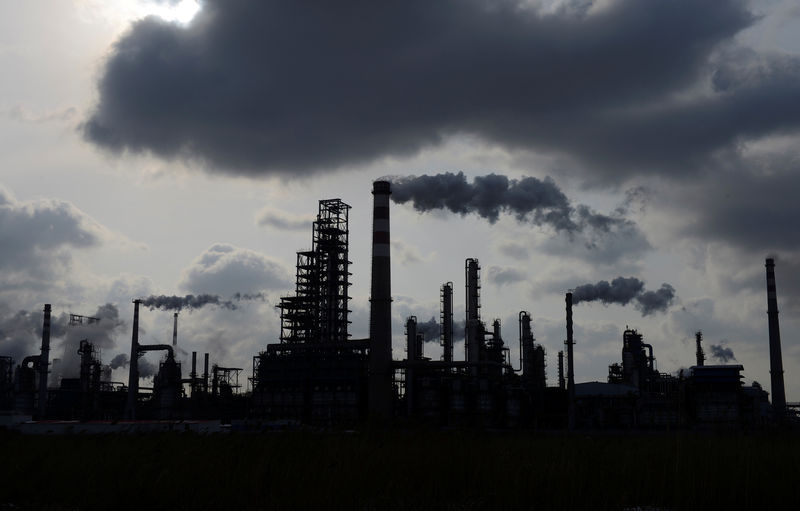 © Reuters. FILE PHOTO – Smoke rises from chimneys at a Sinopec refinery in Qingdao
© Reuters. FILE PHOTO – Smoke rises from chimneys at a Sinopec refinery in QingdaoBy Florence Tan, Chen Aizhu and Rania El Gamal
SINGAPORE/BEIJING/DUBAI (Reuters) – Saudi Arabia is set to expand its market share in China this year for the first time since 2012, with demand stirred up by new Chinese refiners pushing the kingdom back into contention with Russia as top supplier to the world’s largest oil buyer.
Saudi Arabia, the biggest global oil exporter, has been surpassed by Russia as top crude supplier to China the past two years as private “teapot” refiners and a new pipeline drove up demand for Russian oil.
Now fresh demand from new refineries starting up in 2019 could increase China’s Saudi oil imports by between 300,000 barrels per day (bpd) and 700,000 bpd, nudging the OPEC kingpin back towards the top, analysts say.
Saudi Aramco said last week it will sign five crude supply agreements that will take its 2019 contract totals with Chinese buyers to 1.67 million bpd.
“With the recent crude oil supply agreements and potential increase of refinery capacity, the Saudis could overtake the Russians and reclaim (the) crown as the biggest crude exporter to China,” Rystad Energy analyst Paola Rodriguez-Masiu said.
Saudi Arabia has already gained ground this year. China imported 1.04 million bpd of Saudi crude in the first 10 months of 2018, China customs data showed. This is equivalent to 11.5 percent of total Chinese imports, up from 11 percent in 2017, Reuters calculations showed.
Saudi’s market share in China could jump to nearly 17 percent next year, if buyers requested full contractual volumes, analysts from Rystad Energy and Refinitiv said, while growth in Russian oil supply to China could slow.
China imported 1.39 million bpd of Russian crude in January-October this year, about 15 percent of total Chinese imports, customs data showed. Russia had a 14 percent share at 1.2 million bpd in 2017.
“We expect Chinese imports of Russian crude to remain at a similar rate in 2019 as a large share of these Russian barrels are imported via pipeline,” Refinitiv analyst Mark Tay said.
Graphic: China’s top crude oil suppliers by market share – https://tmsnrt.rs/2PKcVZF
NEW CUSTOMERS
The biggest boost to Saudi exports to China comes from contracts inked with new refineries starting up this year and next, owned by companies other than state oil giants Sinopec or PetroChina.
The contracts include 130,000 bpd to Dalian Hengli Petrochemical and up to 170,000 bpd to Zhejiang Petrochemical Corp, each of which has a 400,000-bpd refinery.
Saudi Aramco has also agreed to increase Sinochem Corp’s supplies, which will be processed at its Quanzhou and Hongrun refineries.
Sinopec, PetroChina and China National Offshore Oil Corp have all kept their term Saudi volumes for next year unchanged.
Beijing-based consultancy SIA Energy expects Saudi crude imports to rise by just 300,000 bpd in 2019, raising its market share to 13.7 percent, but leaving it behind Russia.
“We expect lower Saudi crude demand from Hengli and Rongsheng as it is unlikely for them to run their refineries at full rate in 2019,” analyst Seng Yick Tee said.
Zhejiang Petrochemical is majority-owned by Rongsheng Holdings.
Still, a source familiar with Aramco’s export plans said there is tremendous appetite from China’s independents, and that it needed to be more aggressive in its marketing strategy.
The state oil company did move more swiftly to seal the most recent deals than it used to in the past, industry sources said.
Aramco’s first deal with Hengli was to supply 20 million barrels of crude, about 55,000 bpd, in 2018, said a senior source with direct knowledge of the deal.
“Hengli executed the 2018 deal nicely, which helped build trust,” he said.
Hengli is designed to process 90 percent Saudi crude, a mix of Arab Medium and Arab Heavy, while the remaining 10 percent is Brazilian Marlim crude. Rongsheng’s plant is identical to Hengli, the industry sources said.
The sources spoke on condition of anonymity.
Aramco is also supplying PetroChina’s refinery in China’s southwestern Yunnan province with about 4 million barrels a month of crude via a pipeline from Myanmar between July and November, Eikon data showed, although sources said talks for Saudi Arabia to acquire a stake in the refinery have stalled.
Saudi Aramco’s Chief Executive Amin Nasser said on Monday the company will push to expand its market share in China and is still looking for new refining deals there despite OPEC’s likely limits on output next year.
Graphic: China crude oil imports by country – https://tmsnrt.rs/2PPwEaA
MAY CUT OIL EXPORTS TO U.S.
Saudi Aramco will supply up to 70 percent of the oil required at its 300,000-bpd joint venture refinery in Malaysia with Petronas. Between China and Malaysia alone, Saudi Arabia will have to increase exports to Asia by more than 500,000 bpd next year.
This comes as the Organization of the Petroleum Exporting Countries (OPEC) is discussing production cuts of as much as 1.4 million bpd for next year to prop up oil prices.
Between balancing global supplies and increasing market in Asia, Aramco may decide to “forgo market share in other markets like the United States, where the surge in domestic production will make it difficult for the Saudis to retain market share anyway,” Rystad’s Rodriguez-Masiu said.
Saudi’s oil shipments to the United States have risen recently to above 1 mln bpd, but U.S. output is also increasing, said the source familiar with Saudi Aramco’s export plans.
“You need to lessen the inventories in the U.S.,” the source said, adding that Aramco will likely divert oil supply from the United States to Asia to meet rising demand there.
A Chinese oil executive said: “China is where the demand growth is. The Saudis are very wise to capture this market.”
Graphic: oil imports from Saudi Arabia – https://tmsnrt.rs/2PNG723
Source: Investing.com




























